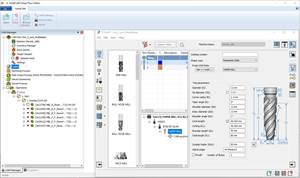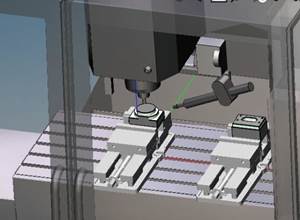What CAM Functions Do Moldmakers Want?
In development of CAM software products, vendors must establish priorities and allocate resources accordingly. The priorities are primarily determined by the market or markets they wish to serve and the product's user.
Share





In development of CAM software products, vendors must establish priorities and allocate resources accordingly. The priorities are primarily determined by the market or markets they wish to serve and the product's user. For example, aerospace users typically require a strong simultaneous five-axis capability, production machining users need effective support for multi-functional machines such as mill-turns, and moldmakers want strong three-axis milling functionality.
CIMdata surveyed moldmakers worldwide to learn which product functions they deemed most important. Twenty-one functions were defined, and moldmakers were asked to rate their importance on a scale of 1 to 5, with 5 being the most important.
The results of the survey confirmed the commonly accepted view that a strong three-axis milling capability is the most important of the 21 defined functions. It had a rating of 4.6 on the 5.0 scale. This is not surprising, since a large fraction of molds contain complex surfaces, and these are typically cut on three-axis milling machines. Further, three-axis milling is usually the most time- consuming and critical element in the mold machining process.
Because three-axis milling is the most important NC programming function in moldmaking and a broad function, CIMdata further defined 18 individual features that are generally considered important within three-axis milling and then asked moldmakers to rate these features. The results indicate that the four most important three-axis milling features, listed in order of importance, are effective gouge avoidance, support of high-speed machining, programming flexibility and automatic rest machining. The average importance ratings for these four features ranged from 4.1 to 4.4.
Given the high cost to produce most molds, effective gouge avoidance is a fundamental requirement, and it is viewed as the most important feature. The use of high speed machining by moldmakers to improve surface finishes and reduce overall shop time is becoming commonplace, and support of this capability is essential for CAM vendors focused on the mold marketplace. Because users like programming flexibility and want to remain in control of the machining process, flexibility is also considered an important feature. Elements of programming automation such as automatic rest milling, in which a toolpath is automatically generated to remove material that was left behind from a previous cut, have gained acceptance.
At the other end of the scale, machining of STL files was the programming feature rated least important, as it garnered an average rating of 2.8.
In the overall functional ranking, strong roughing ranked second to three-axis milling with a 4.4 rating, and tight integration with design software came third with a 4.2 rating. Roughing is a major function that often consumes a significant portion of the overall machining time. A number of newer roughing techniques are now being employed, including rest roughing to remove uncut material and plunge roughing to remove more material in a shorter period of time. Tight integration with design generally implies associativity between creating a model and NC programming. As design changes occur, associativity often permits users to quickly and automatically regenerate a toolpath to accommodate the design change, saving programming time.
Overall worldwide rankings were driven primarily by North American and Japanese moldmakers. European moldmakers considered all three functions important but ranked them differently. They deemed integration of machining with design most important, followed by strong three-axis milling and strong roughing.
Further, European moldmakers chose differently when ranking more detailed 3-axis milling features. At the feature level, their order of importance among the top four worldwide features was support of high speed machining, programming flexibility, effective gouge avoidance and automatic rest machining.
At the lower end of the scale, overall software functions with average importance ratings of less than 3.0 include support of PDM software, support of CMM machines and strong simultaneous five-axis milling. However, CIMdata believes that the importance of each of these functions will increase in time. PDM software is rapidly gaining acceptance in manufacturing companies, and this will likely spread throughout the supply chain. Quality management systems are gaining acceptance, and CMM machines are a component of a quality program.
Lastly, CIMdata believes use of simultaneous five-axis machines in mold shops is increasing in as the price of the machine tool falls, programming becomes easier and the benefits of its use become better established.
Related Content
Building A Powerful Bridge from the CAM Programmer to the Shop Floor Operator
SolidCAM for Operators provides a powerful bridge from CAM programming to the shop floor to best streamline the machine shop process with its CAM part simulation. It provides a clear picture to the operator for setup and prove-out, enables minor G-Code changes and avoids crashes, broken tools and scrapped parts.
Read MoreFaster Programming and Training Helps Automotive Shop Thrive
Features that save on training, programming and cycle times have enabled Speedway Motors to rapidly grow and mature its manufacturing arm.
Read MoreHow Integrated CAD/CAM Transforms Inventions Into Products
The close connection between CAD and CAM is what links creative ideas to practical production for this unique custom manufacturer.
Read MoreOrthopedic Event Discusses Manufacturing Strategies
At the seminar, representatives from multiple companies discussed strategies for making orthopedic devices accurately and efficiently.
Read MoreRead Next
AMRs Are Moving Into Manufacturing: Considerations for Implementation
AMRs can provide a flexible, easy-to-use automation platform so long as manufacturers choose a suitable task and prepare their facilities.
Read MoreMachine Shop MBA
Making Chips and 91ÊÓƵÍøÕ¾ÎÛ are teaming up for a new podcast series called Machine Shop MBA—designed to help manufacturers measure their success against the industry’s best. Through the lens of the Top Shops benchmarking program, the series explores the KPIs that set high-performing shops apart, from machine utilization and first-pass yield to employee engagement and revenue per employee.
Read MoreLast Chance! 2025 Top Shops Benchmarking Survey Still Open Through April 30
Don’t miss out! 91ÊÓƵÍøÕ¾ÎÛ's Top Shops Benchmarking Survey is still open — but not for long. This is your last chance to a receive free, customized benchmarking report that includes actionable feedback across several shopfloor and business metrics.
Read More


















